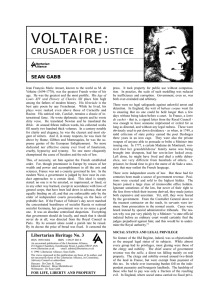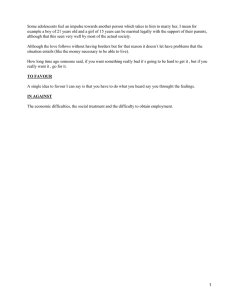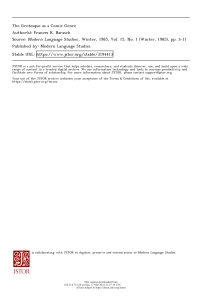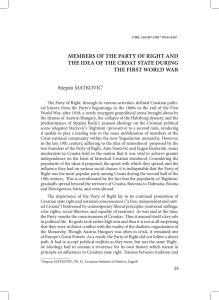Documento 8891
Anuncio
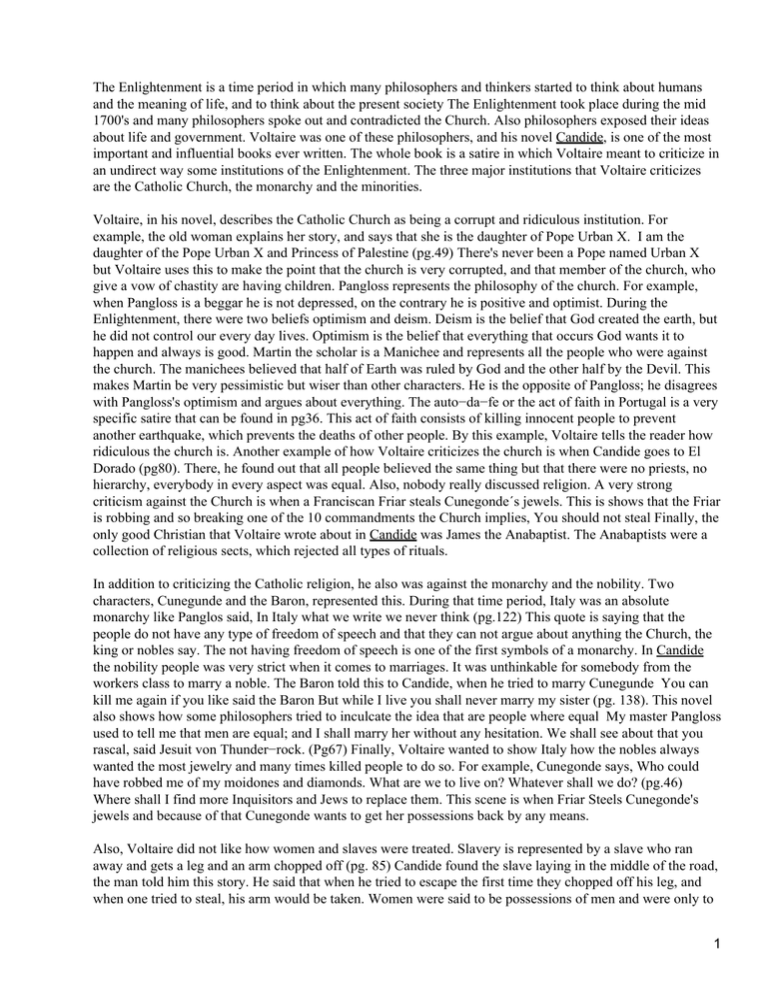
The Enlightenment is a time period in which many philosophers and thinkers started to think about humans and the meaning of life, and to think about the present society The Enlightenment took place during the mid 1700's and many philosophers spoke out and contradicted the Church. Also philosophers exposed their ideas about life and government. Voltaire was one of these philosophers, and his novel Candide, is one of the most important and influential books ever written. The whole book is a satire in which Voltaire meant to criticize in an undirect way some institutions of the Enlightenment. The three major institutions that Voltaire criticizes are the Catholic Church, the monarchy and the minorities. Voltaire, in his novel, describes the Catholic Church as being a corrupt and ridiculous institution. For example, the old woman explains her story, and says that she is the daughter of Pope Urban X. I am the daughter of the Pope Urban X and Princess of Palestine (pg.49) There's never been a Pope named Urban X but Voltaire uses this to make the point that the church is very corrupted, and that member of the church, who give a vow of chastity are having children. Pangloss represents the philosophy of the church. For example, when Pangloss is a beggar he is not depressed, on the contrary he is positive and optimist. During the Enlightenment, there were two beliefs optimism and deism. Deism is the belief that God created the earth, but he did not control our every day lives. Optimism is the belief that everything that occurs God wants it to happen and always is good. Martin the scholar is a Manichee and represents all the people who were against the church. The manichees believed that half of Earth was ruled by God and the other half by the Devil. This makes Martin be very pessimistic but wiser than other characters. He is the opposite of Pangloss; he disagrees with Pangloss's optimism and argues about everything. The auto−da−fe or the act of faith in Portugal is a very specific satire that can be found in pg36. This act of faith consists of killing innocent people to prevent another earthquake, which prevents the deaths of other people. By this example, Voltaire tells the reader how ridiculous the church is. Another example of how Voltaire criticizes the church is when Candide goes to El Dorado (pg80). There, he found out that all people believed the same thing but that there were no priests, no hierarchy, everybody in every aspect was equal. Also, nobody really discussed religion. A very strong criticism against the Church is when a Franciscan Friar steals Cunegonde´s jewels. This is shows that the Friar is robbing and so breaking one of the 10 commandments the Church implies, You should not steal Finally, the only good Christian that Voltaire wrote about in Candide was James the Anabaptist. The Anabaptists were a collection of religious sects, which rejected all types of rituals. In addition to criticizing the Catholic religion, he also was against the monarchy and the nobility. Two characters, Cunegunde and the Baron, represented this. During that time period, Italy was an absolute monarchy like Panglos said, In Italy what we write we never think (pg.122) This quote is saying that the people do not have any type of freedom of speech and that they can not argue about anything the Church, the king or nobles say. The not having freedom of speech is one of the first symbols of a monarchy. In Candide the nobility people was very strict when it comes to marriages. It was unthinkable for somebody from the workers class to marry a noble. The Baron told this to Candide, when he tried to marry Cunegunde You can kill me again if you like said the Baron But while I live you shall never marry my sister (pg. 138). This novel also shows how some philosophers tried to inculcate the idea that are people where equal My master Pangloss used to tell me that men are equal; and I shall marry her without any hesitation. We shall see about that you rascal, said Jesuit von Thunder−rock. (Pg67) Finally, Voltaire wanted to show Italy how the nobles always wanted the most jewelry and many times killed people to do so. For example, Cunegonde says, Who could have robbed me of my moidones and diamonds. What are we to live on? Whatever shall we do? (pg.46) Where shall I find more Inquisitors and Jews to replace them. This scene is when Friar Steels Cunegonde's jewels and because of that Cunegonde wants to get her possessions back by any means. Also, Voltaire did not like how women and slaves were treated. Slavery is represented by a slave who ran away and gets a leg and an arm chopped off (pg. 85) Candide found the slave laying in the middle of the road, the man told him this story. He said that when he tried to escape the first time they chopped off his leg, and when one tried to steal, his arm would be taken. Women were said to be possessions of men and were only to 1 be used to satisfy the man sexually and to the household (cleaning.) Women had to take care of the children and sometimes work. for some money, although not much because women were paid less. Also, women had no opinion about anything. For example, both the Governor and Candide want Cunegonde and they discuss to see who can take her, but cunegonde never opinates. Candide is a way to display the absurdity of the people's view toward slaves and women. The Catholic Church, the monarchy and the minority groups were the three main institutions that Voltaire tried to satirize and criticize. Voltaire, by writing this book tried to tell the world in an indirect way how the world was really working and its mistakes. Candide, considered one of the most influential books ever written was meant to contribute in a small way to change the society during that time period, the Enlightenment. ððððððð Voltaire 2
